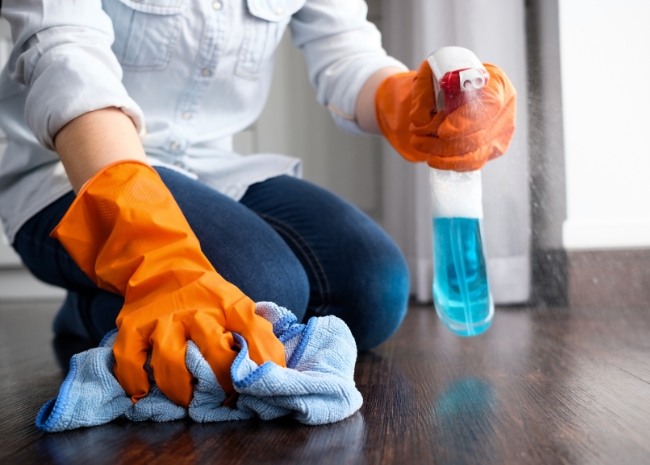
Spring Cleaning and the Pain That Follows: How to Prevent & Treat Common Injuries
The urge to deep-clean our homes can strike at any time—whether it’s a seasonal refresh, a round of spring cleaning, or just the need to restore order.
But scrubbing floors, reaching into forgotten corners, and reorganizing closets can leave us feeling stiff and sore.
Common Pains After Cleaning Include:
- Back Pain: The repeated forward bending, twisting, and carrying heavy loads can cause muscle fatigue, tightness, and even strain the spine.
- Neck and Shoulder Pain: Cleaning can create tension in the neck and shoulders. Poor posture, such as hunching forward or overreaching, can also contribute to stiffness and discomfort.
- Knee Pain: Kneeling, squatting repeatedly, or stretching into awkward positions can put stress on your knees. Hard surfaces can increase discomfort, and excessive bending without support can aggravate knee joints.
- Wrist and Hand Pain: Repetitive scrubbing, wringing out rags, and gripping cleaning tools for long periods can lead to wrist and hand pain. Overuse can even contribute to conditions like tendonitis or carpal tunnel syndrome.
Let’s dive into why these pains happen and how you can tackle them effectively.
Why Do These Pains Occur?
Understanding the root cause of post-cleaning pain can help you take steps to manage it.
Here’s why these aches creep up:
- Repetitive Motion: Cleaning involves a lot of repeated actions—scrubbing, wiping, lifting, and vacuuming—all of which can lead to muscle fatigue and soreness.
- Poor Posture: Many cleaning tasks involve bending, twisting, or hunching over, which can strain muscles and joints. Maintaining the same position for too long or overextending certain muscles can lead to discomfort.
- Overuse of Muscles: If you’re not regularly engaging in physical activity, a full day of cleaning can push your muscles beyond their usual limits, leading to soreness and inflammation.
- Lack of Support: Hard floors can be tough on the knees, and improper footwear can contribute to back, leg, and foot pain. Unsupported movements, like lifting without engaging your core, can strain muscles and joints.
How to Prevent Pain During Spring Cleaning
Preventing pain starts with being mindful of how you move while cleaning.
Follow these strategies to protect your body and avoid unnecessary aches:
1. Maintain Good Posture
- Avoid hunching over or twisting your body in awkward ways.
- Keep your spine aligned and engage your core when lifting objects.
- Use a step stool instead of overreaching for high spots.
2. Use Proper Lifting Techniques
- Bend at your knees, not at your waist.
- Keep heavy objects close to your body while carrying them.
- Lift slowly and avoid sudden jerky movements.
3. Take Breaks and Alternate Tasks
- Don’t power through hours of cleaning—give yourself short breaks to stretch and rest.
- Alternate tasks to prevent overuse of the same muscles (e.g., vacuum a room, then dust instead of vacuuming everything at once).
4. Wear Supportive Footwear
- Avoid cleaning barefoot or in unsupportive shoes.
- Wear cushioned, non-slip shoes to support your back and joints.
5. Use Ergonomic Cleaning Tools
- Long-handled dusters and scrubbers can reduce bending and reaching.
- Lightweight vacuums and mops can ease strain on your arms and shoulders.
- Kneeling pads can protect your knees when cleaning floors.
6. Warm Up Before Cleaning
- Stretching beforehand can loosen muscles and prepare your body for movement.
- A few minutes of light stretching, like shoulder rolls and leg swings, can help prevent stiffness and injury
How to Recover from Cleaning-Related Pains
If you wake up feeling sore after a cleaning marathon, don’t worry—there are ways to ease the discomfort and get back to feeling great.
1. Stretch It Out
Gentle stretching can relieve muscle tightness and improve circulation.
Try these simple moves:
- For Back Pain: Cat-cow stretch, child’s pose, and seated spinal twists.
- For Neck and Shoulders: Shoulder rolls, neck tilts, and doorway chest stretches.
- For Knees: Quad stretches and knee-to-chest stretches.
- For Wrists and Hands: Wrist flexor stretches and finger extensions to ease tension.
2. Apply Heat or Ice
- Ice packs can help reduce inflammation, especially for knee pain or swelling. Apply for 15-20 minutes at a time.
- Heat therapy (like a warm bath, heating pad, or hot towel) can relax tense muscles and improve circulation. Use heat for stiff muscles but avoid it if swelling is present.
3. Rest and Hydrate
- Give your muscles time to recover by taking it easy for a day or two.
- Hydration is also key—drink plenty of water to help flush out toxins and reduce muscle cramping.
4. Use Self-Massage or Foam Rolling
- Massaging sore areas with your hands or using a foam roller can help relieve tension and improve muscle recovery.
- For the back and shoulders, a tennis ball against the wall can work wonders.
How Physical Therapy Can Help
If you find yourself dealing with persistent pain after cleaning (or any activity), a physical therapist can help.
- Pain Relief Techniques: Physical therapists use manual therapy, massage, and guided exercises to reduce pain and improve mobility.
- Strengthening Exercises: Building core and muscle strength can make everyday activities, including cleaning, easier and less taxing on your body.
- Postural Training: Learning how to move correctly and maintain good posture can prevent future pain and injuries.
- Personalized Recovery Plans: If you have chronic pain or past injuries, a physical therapist can create a tailored plan to help you recover and stay pain-free.
Final Thoughts
Cleaning doesn’t have to leave you sore for days.
By understanding why these pains occur and following recovery tips, you can keep your body feeling great while keeping your home spotless.
And if pain persists, don’t hesitate to reach out to our physical therapists—your body will thank you!
The Jackson Clinics serves 18 locations throughout Northern Virginia.
Find one near you: thejacksonclinics.com/locations

















